How Much Should I Spend on Marketing?
 What is your aviation marketing budget? That’s a question many of our clients (and prospects) hesitate to answer- some because they don’t want to tell a potential vendor, which is understandable, and some, because they honesty don’t HAVE a marketing budget. Which is understandable. But also frightening.
What is your aviation marketing budget? That’s a question many of our clients (and prospects) hesitate to answer- some because they don’t want to tell a potential vendor, which is understandable, and some, because they honesty don’t HAVE a marketing budget. Which is understandable. But also frightening.
It’s unlikely that a business will acquire enough customers to stay healthy by “accident,” and a lack of a budget indicates a lack of a plan.
A lack of a plan indicates that they’re indulging in something expensive and wasteful that we call “random acts of marketing.”
So, John and I tackle the first of our series of frightening subjects (most involving math) as we approach Halloween . . .
Transcript – Your Aviation Marketing Budget – How Much Should You Spend on Marketing?
 Paula Williams: Welcome to Aviation Marketing Hangar Flying Episode number 51. It is hard to believe that we [LAUGH] have had more than 50 episodes.
Paula Williams: Welcome to Aviation Marketing Hangar Flying Episode number 51. It is hard to believe that we [LAUGH] have had more than 50 episodes.
John Williams: Yeah, really.
Paula Williams: That’s crazy.
John Williams: So, I’m turning the volume down a little bit so we can get started. Okay.
Paula Williams: All right, so today we’re going to be talking about How Much Should I Spend on Marketing?
This is a question that we get a lot. And it’s probably a question a lot of people are afraid to ask us because we are marketing consultants. So of course we’re going to say, it’s going to cost you $5 million, when people [LAUGH] cant really afford that much, right?
John Williams: Yeah, we’re not going to do that though.
Paula Williams: Exactly, so I’m Paula Williams.
John Williams: And I’m John Williams.
Paula Williams: And we are ABCI and ABCI’s mission is:
John Williams: To help tell all you folks out there sell more stuff, products and services in the aviation world.
Paula Williams: Absolutely, all right, so we do have a hashtag and it is #AvGeekMarketing and we will reply to every tweet or a message that we see in social media.
And we do try to keep up on that. So, if you have questions, comments, anything about this episode or any other, of course you’re welcome to comment on our blog or any of the social media that you have a proclivity to use, right. [LAUGH]
John Williams: Exactly.
Paula Williams: For John, that would be LinkedIn.
And for me, that would be all of them. So everybody’s different, right. So you are probably wondering, how much should you be spending on marketing? Either as a percentage of your total budget or your total revenue and everything else. Or how much should you be spending for the specific bits and pieces that you’re doing, right?
John Williams: Yes.
Paula Williams: Okay, now I know when you buy things, John, you have a process that you go to. And you almost never will tell a salesperson what your budget is.
John Williams: No, I typically don’t.
Paula Williams: [LAUGH] And why is that?
John Williams: Because then I suspect then I suspect that they’re going to go right for the top.
Paula Williams: They’re going to go right-
John Williams: [CROSSTALK] Just like a real estate person does.
Paula Williams: Top number, exactly, and make you spend everything that you had planned to spend. And honestly when you’re dealing with a lot of salespeople, that is a concern, right?
John Williams: Yes, it is.
Paula Williams: In fact, a lot of, I think, company owners are concerned about letting their team know what their budget is.
And this, actually, I thought was a good quote from a Forbes Magazine. There’s a mentality out there that if you have a budget, you will end up just wasting it, because once you define how much money you’re going to spend, it’s as if you’ve already spent it. [LAUGH] Would you agree with that?
John Williams: Well.
John Williams: No.
Paula Williams: Okay.
Paula Williams: I think you have to have a budget. You don’t necessarily have to tell us or tell anybody what it is. But if you don’t have a budget, you’re just barking in the dark, right?
John Williams: Yeah, you gotta have a budget. There’s just no other way around that.
Paula Williams: Right, exactly, and the problem with not having a budget, the biggest problem, is that you end up resorting to random acts of marketing. Because you don’t really have a plan. If you don’t have a budget, you don’t have a plan for what kind of marketing that you’re planning on doing that year.
And so things come up, like a trade show or like an advertisement opportunity or any other thing that looks like a good idea, and it doesn’t fall inside or outside of your plan because you don’t have a plan. [LAUGH]
John Williams: Yeah, if you got a budget at least you know when you got to that number of dollars if you want to spend more on that particular line item, then you have to redo the budget and see where you gotta take it out of.
Paula Williams: Exactly, so what typically happens when people don’t have a budget is they get to their year end review when they do there taxes and they figure out how much they spent on all of the things they want to do deductions on their business expenses and things like that.
And then they look at how much they spent time marketing and then they do one of these. They have [LAUGH] sticker shock and they go, holy cow, we spent $5,000 on marketing last year and what do we get for it, right?
John Williams: Yeah, you should know that along the way.
Paula Williams: You should know that along the way. It really shouldn’t be a surprise when you do your taxes at the end of year. In fact, whatever you spent last year, [LAUGH] that is a really good indication of what you should be spending this year, unless things didn’t work out the way that you wanted them to, right?
John Williams: Or you spend the same amount, but you allocate it differently.
Paula Williams: Exactly, so one of the easiest ways to do this is toward the end of the year, and we’re getting kind of towards the end of the year here. You probably want to look at, how much did I spend on all of these items, and trade shows are probably the biggest expense that a lot of companies have, including the travel and the booth and all of the different bits and pieces with those.
And they often end up costing us a lot more than we had expected. Events are another big expense. And we’re not saying that you should or shouldn’t do any of these things. It’s just that you should know what you spent on each of them. And as you do each of these things, and you consider each of these line items, you want to think about, how many customers did you get from that source?
John Williams: Of course, because as everybody knows, or if you don’t, then don’t be shocked.
Paula Williams: [LAUGH]
John Williams: But every customer has a cost.
Paula Williams: Right, they don’t come for free, people. [LAUGH] If you want customers, you do have to spend money to get them. They have to find you in some way.
Whether that’s through your website or your social media or an email or any number of things. Or maybe you did a sales call and went to see them. Somehow, they found you or you found them and you spent money on that relationship before it became a sale most likely.
So if you’re keeping track of all of these things, it’s going to be so much easier next year to do your budget, right?
John Williams: Of course.
Paula Williams: And we also have a nice spreadsheet that makes it really simple to keep track of these things and to download that and we’ll tell you about that in a few minutes.
So don’t worry about writing down all of these things. But if you’re listening to this, some of the things that you might’ve spend money on last year. Trade shows, events, advertisements, branding, printing, postage, consulting, email, CRM software. Other marketing software, retargeting software, social media, website, education sessions, thought leadership, speaking engagements, webinars, online assets like apps, reservation systems, calculators, referral programs, sales tools training, and travel.
John Williams: And so forth.
Paula Williams: And so forth, yeah, that’s a lot of different things, and there’s more than that. This is just to get you started thinking about some of the things that you’ve spent money on that actually do fall into the marketing category. So, your marketing budget probably actually is bigger than you think it is.
You just want to make sure that you have control of that money. So that is certainly worth doing. So the next thing you want to think about is, what do I have to show for it? [LAUGH] You’ve spent all that money, what did it do for you?
John Williams: You should have more customers, or at least a lot more stuff in your pipeline.
Paula Williams: Exactly, and how would you know which of those activities brought you which of your customers?
John Williams: Research.
Paula Williams: You ask them. How did you find us?
John Williams: Yeah, once you get customers, sure, but-
Paula Williams: [CROSSTALK] Exactly, so that’s really important to ask them, but keep in mind that it’s probably more than one thing.
Almost everybody has more than one contact with you. They may have met you at a trade show, and then they got a mailer, and then you had a sales call. There may have be three or four different things that you did to get one particular customer. But the best way to find out is to ask.
Because the most memorable thing is what is going to stick in their head.
John Williams: And all those three or four things of course will be in your CRM.
Paula Williams: Exactly, and some of your last year sales are of course going to come from repeat sales from years prior and everything else, but new customers are all going to come from one marketing activity or another.
Absolutely, right? Okay, you also want to look at your new leads in the pipeline. Because those are worth something, even if they haven’t closed yet at the end of the year. Depending on your sales, a lot of our clients have an eight month sales cycle. It take eight months from the time they first meet to the time that they actually close any business.
John Williams: From those in the used airplane business, this is going to be even longer than the way things are.
Paula Williams: [LAUGH] Exactly, so the leads in your pipeline are worth something even if they haven’t resulted in a new business. And then you also want to look at what reusable marketing assets do you have.
Things that you can use more than once. Like, did you invest in trade show graphics or printed materials that you still have a box of that you can use? Do you have a great sales letter that you had someone write that works and you know it works and you can keep sending it out over and over again?
Do you have online materials that are still getting hits, they’re still getting traffic? And did you spend money or did you invest in your team, in your sales or marketing team by getting them some new or better tools and, or training? All of those things are worth money, right.
John Williams: Yes.
Paula Williams: Harder to quantify.
John Williams: Yeah, the accountant’ll laugh at you, or the CPA, but still, these are the things that get you customers.
Paula Williams: Exactly.
John Williams: Or keep the customers.
Paula Williams: Right, so in your MBA program, you used to evaluate businesses, right? Did you look at some of these things?
John Williams: We valuated businesses, yes, we did.
Paula Williams: [LAUGH] Not evaluate but valuate.
John Williams: Yes, there’s a valuation process. Well, of course, you look at everything, not down to that detail necessarily. It depends on the company.
Paula Williams: Right, but in a lot of cases these are things that are assets that are worth a lot to you because you’re ready to go out and make more sales and it saves a lot of time in between now and closing if you’ve got all your bits and pieces together.
John Williams: Yeah, if you can put all this stuff together at some expense to start with but you’ve done a good job, then you can use them with minor modifications in the following timeframes.
Paula Williams: Okay, right, so now you’re probably feeling better. [LAUGH] You’ve gotten over your sticker shock and you’ve looked at the pile of things that you have to show for it.
Hopefully, your sales far exceed the amounts of marketing that you’ve done, unless you’re a brand new company. And that sometimes happens that people invest more in marketing than they make in their first few years actually. It’s a tough business to break into. But in general, you should have a lot more sales, a lot more new customers, new leads in the pipeline and assets that you’ll have ready to use.
And all of those things are worth money and they’re worth investing in. So if you’ve done a good job last year, you have a big pile of this stuff to show up on the other side of the ledger.
John Williams: Yes.
Paula Williams: Okay, another thing to think about is competitors.
If your competitors are doing really aggressive advertising and you are not, what do you think is going to happen here?
John Williams: [LAUGH] I would say that just like the picture you may be looking at, they’re going to come out on top.
Paula Williams: We’re going to kick your butt! So if you have a competitor that’s taking a lot of your customers, either by taking all the traffic from your website or drawing the big crowds at trade shows or gobbling up all the ad space in your customers’ favorite magazines.
Whatever it is, that’s something that you really need to take into consideration and think about, when I’m doing my budgeting for advertising for next year, if I don’t have very many competitors or they’re not very aggressive, it doesn’t need to be very high budget. But if your competitors are kicking your butt, a dog can’t win a horse race, right?
John Williams: That’s right, you gotta go out there and figure out where you can improve what you’re doing and figure out what it’s going to cost.
Paula Williams: Exactly, so there’s two strategies there. One is to go big, go bigger than your competitor. And the other is to change the game and either change your product or change the audience that you go after or specialize in some way so that you are capitalizing on a smaller part of that audience.
So if you don’t have a huge budget, you don’t necessarily have to go head to head. But you do have to have a good strategy here, right?
John Williams: Exactly.
Paula Williams: Okay, the other thing you need to think about is expectations. What are people going to be saying about you if you discontinue a trade show that you’ve been at for the last 20 years?
Or an advertisement that you’ve had in a magazine for the last ten years or something like that?
John Williams: Even the large companies, people wonder if they’re having a bad time.
Paula Williams: Mm-hm.
John Williams: Smaller companies they’ll wonder if you’ve gone out of business.
Paula Williams: Right, so, again, you need to have a strategy here.
It is okay to not go to a trade show and say, you know what, this isn’t profitable, let’s not do this anymore. But you want to make sure that you communicate to your stakeholders, your customers and your prospects, we’re not going to that show and here’s why. You can see us at this other shows and we’re doing all of this other things.
John Williams: Right.
Paula Williams: So you want to make sure that everybody knows and they’re not making assumptions and talking behind you back, right?
John Williams: They’ll make assumptions anyway, but at least you can head them off.
Paula Williams: [LAUGH] Right, exactly. Okay, so what we like to do, once you’ve gone through this exercise and you have your budget from last year.
You know where your customers came from. You know where your prospects came from and all of those things. You want to make a wish list, and while you’re doing this, there’s kind of two extremes that you can go into here. One of them is Santa Claus and the other one is the Grinch, right?
And I like to separate everything into two processes. There’s a creative process and then there’s a critical process. And if you try to do both at the same time, you’re going to strangle yourself, right? You can’t be Santa Claus and the Grinch at the same time. So what you need to do is go through this exercise twice, once as Santa Claus and then again as the Grinch.
So the first time, you want to write down everything. Assume that money is no object. What could you do to advertise your company more successfully? What would you want to do? And write everything into a wish list. And then you’re going to go back through it again and be the Grinch.
[LAUGH] And prioritize all of the things that you wrote down. We’re going to talk about how to project potential revenue from each and figure out what you can spend on them this year so that you’re using your money in the most helpful possible way, right? Most effective possible way.Okay, so the first thing you’re going to do is go through your wish list, and you can download this spreadsheet from our website at abci1.com/budget, right? And put on your Santa Claus hat! Okay, so what you’re going to do is you’re going to fill this out and you can add rows to this spreadsheet so that you have all of the bits and pieces that you want.
And we decided to be really, really helpful and add in some of ABCI’s products that you may want to consider in next year’s budget. [LAUGH]
John Williams: And this is actually an Excel spreadsheet. So it’s not something you write in, you usually pop them out of your computer and type into it.
Paula Williams: Okay, right, you type into it, but I meant write as in type, but-
John Williams: [CROSSTALK] Uh-huh.
Paula Williams: Exactly, it is an Excel spreadsheet and it will expand as you type into it, you just add rows as you do that. So, you can see that we’ve got three places for trade shows, but you may be doing one or five or however many you do.
So you’ll want to customize this as you go. We just added in a number of things to get you started thinking about the items that you could use in your marketing plan. So the first thing you want to do is fill out that left-hand column and write in all of the things you want to do and excuse my handwriting.
That was terrible. Let’s try that again. That’s a little better. Okay, so all of the aviation marketing activities that you think you want to do and then you can put in, how much did you spend last year on those things? So, you also want to put in, while you’re thinking in your Santa Claus point of view, you want to be using your optimistic mode.
How many reusable assets did you acquire? And if you want to put a value on those, or if you just want to put notes in that column, that’s fine, too. This is not going to be one that adds up, it’s just going to be a column of notes that go into your thinking.
And you also want to put in the potential benefit any notes that you have there. So the potential benefit might be a strategy to counter a competitor or it might be, this is a really good show to reach a specific audience. So, you have a place to put all of those things.
We’re not going to fill in the priority yet because that’s the last thing we’re going to do. Once you get all of that and you’re figuring through all of this, you want to think through, what is the potential revenue from each of these things? In fact, one way to do this is to put in the total potential revenue, how much do you want to make next year, right?
And then you go back through and say, where are those customers going to come from? Because they’re going to come from somewhere. It’s going to come from some line item on this spreadsheet. So, you want to think about, what is your potential revenue and put that in. So, after you do all of that and you have a pretty good view of the optimistic view of your spreadsheet, what do you think so far, John?
John Williams: You’re doing the talking, I’m just.
Paula Williams: [LAUGH] Okay, that’s cool. I know you’re going to chime in on this part. [LAUGH] This is the Grinch side. So, once you’ve finished all of that,and you’ve got some good notes and numbers and everything else in your spreadsheet, you’re going to fill in your estimated cost and your estimated budget, right?
How much is it actually going to cost for you to get this done and how much are you going to budget for the year? So for example this might be a monthly cost. Or you may do four or five trade shows, so then you’ll want to carry that over, multiply it, do whatever you need to do to make that an annual budget, right?
Make sense?
John Williams: Of course, to me.
Paula Williams: Okay, good, exactly, it’s a spreadsheet. So it should make everybody feel all warm and fuzzy inside. People with Santa hats, people with Grinch outfits. Everybody on your team should be really comfortable with some [LAUGH] part of this process, which also why it’s really helpful to do this as a team.
Okay, now the one problem that we haven’t talked about yet is this very first column, which I told you to ignore and that is priority, right? And the reason we ignored that is because now we know what our potential revenue is, we know what our estimated costs are, we know what our estimated budget is.
And then we want to prioritize because most of us are going to finance marketing activities with money that we make along the way. We may not have all of this money stacked up in the bank January 1 for the year’s marketing activities, right? So some of these things we’re going to have to prioritize and we will be able to do them, if we meet certain performance expectations.
And we’re not going to be able to do them if we don’t. So that’s why a priority is very, very important. So you’re going to want to type in a priority of each of these things and say, these are the things that we think are the most and least important. So you’re going to put them in some kind of an order and then you can sort your spreadsheet.
Print it out and hang it on your wall!
John Williams: And if you come out with more than one Priority 1, then you have to prioritize the Priority 1.
Paula Williams: [LAUGH] The 1.5, 1.75.
John Williams: Exactly, because there can only be one Priority 1.
Paula Williams: Exactly, everything needs to have a numerical value and not everything can be a Priority 1.
But yeah, you do want to have an idea of what are the very most important things that you’re going to be spending money on next year? And what are the not-so-important things that you’re going to be spending money on? And this doesn’t have to be done by year. You can do it by month or by quarter, whatever’s the most convenient for the way that you do your accounting and budgeting, right, John?
John Williams: Exactly, and this is just a sample to get you started so you don’t have to create the damn thing to start with. So you can feel free, take any creative license you want.
Paula Williams: Exactly, it’s just a blank spreadsheet, you can’t break it. You can always download it again, if you screw it up, right?
John Williams: Right.
Paula Williams: [LAUGH] Okay, so yeah, the intention here really is to take a lot of the work out of it for you. We’re going into October, we’re going to be talking about a lot of things that are scary for a lot of people having to do with numbers and having to do with marketing.
They usually scare the crap out of marketing teams and their bosses and the accountants and everybody else. So we really want to take the fear out of the whole process. And the more you know, the better this gets. John’s a master at moving numbers around on a spreadsheet until stuff works.
If I tell him, we really need to do this next year, he’ll move stuff around on spreadsheets until he can make it happen. And if you’ve got somebody in your organization that’s really good at that, that’s great. If not, it’s really not that hard. Once you learn how to plug some numbers in, do some sorting, it becomes a lot more clear, and then you can see it, and then it’s not nearly as frightening as an unknown.
We’re running out of money kind of feeling.
John Williams: Yeah, and who are you and what did you do with Paula?
Paula Williams: [LAUGH]
John Williams: You don’t like spreadsheets.
Paula Williams: I know, I keep whining every time he brings out the spreadsheets because it’s not my favorite thing to do. But it really is my favorite thing when it lets me do what I want.
John Williams: [LAUGH]
Paula Williams: Which is spend money on a marketing activity, right?
John Williams: Of course.
Paula Williams: Okay, so that is a wonderful thing. And it really is magical when you start to look at your numbers and figure out where your customers are really coming from. What’s working for you, what’s not working for you.
It really takes all of the mystifying weirdness out of the whole process.
John Williams: And because then you find out how much you’d like to spend for next year as an example, and then you say, okay, we need to make some money or we got this covered.
Paula Williams: Exactly, and another thing that you want to do is once you start getting these numbers down, you have some options.
So, of course you’re going to want to do the things that made you the most money last year. But you’re also going to notice that a lot of things aren’t changing, more people are getting onto different social medias. So if you were using maybe one particular advertisement last year and you’ve noticed that it’s dropped some since the year before, you might want to try a few things to replace that.
It’s always good to have as many hooks in the water as you possibly can. Because as the weather changes, as the currents change, as other kinds of things change, the more marketing activities you have going on, the more stable really your business is.
John Williams: And even though you have things that are repeatable and they work, you need to be playing a little bit with some other things along the way because you will get surprised, either goodly or badly.
Paula Williams: [LAUGH] Goodly or badly?
John Williams: You get surprised good, then you may have another point you can advertise and draw in more customers.
Paula Williams: Absolutely, so we really recommend having as many of these going on as you can. And if you have to spread your money, maybe do one fewer trade show so that you can do one of the lesser expensive methods, do that.
Because you never know. There was one year when there was a hurricane that just about decimated NDAA. There were so few people there and I know a lot of companies depend on that annual convention as their pretty much their sole source of marketing. And they put a lot of time and a lot of money into it and then they find out that nobody’s there, [LAUGH] nobody’s attending because they can’t fly into Florida.
John Williams: Exactly.
Paula Williams: So weird things do happen. So it’s always good to have a backup plan and it’s always good to have a diversified plan, so that if one thing doesn’t work out, you got other things that are keeping you afloat, right? Cool, all right, so you can download the budget worksheet.
It’s just an Excel file, so don’t be afraid. [LAUGH] You can fill it in, blank it out as many times as you want. You can make as many copies of it as you want, do things and other kinds of things but you can find on ABCI1.com/budget, that’s alpha bravo charlie india one dot com forward slash budget.
If you’re interested in this topic, you’re going to find things that you want to do at different points during the year. So, you may also want to look at the marketing calendar Episode 8. Look at Budgeting and Holidays episode 10, we’re coming up on the holidays right about now, so that’s a good one to listen to.
Again, if you haven’t already, or for the first time, Trade Show Disasters and How to Avoid Them. This is probably your biggest money saver. If you can not go to a bad trade show or not make a disaster out of a trade show, that’s the easiest way to save money on your budget.
John Williams: And it’s first time trade show is an easy way to spend a lot of money.
Paula Williams: Exactly, so go sell more stuff.
John Williams: America needs the business, so says Zig Ziglar. Or said Zig Ziglar.
Paula Williams: [LAUGH] So subscribe to our podcast. It is on iTunes, Stitcher, and Google Play.
Do subscribe so that those episodes do show up on your phone without you having to remember. And then do give us your rating, because that does make a big difference to us to know what you’re thinking and let us know that you’re listening. Have a great week!
John Williams: And we’ll see you next time! Ciao!
} else {..
Podcast: Play in new window | Download
Subscribe: Google Podcasts | Spotify | Amazon Music | RSS



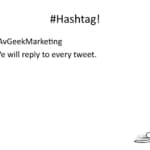

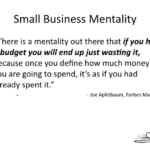

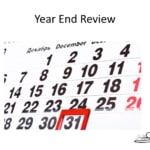

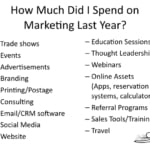
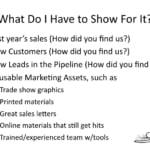





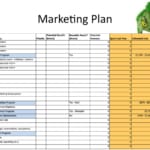

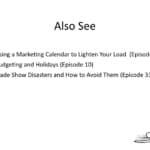
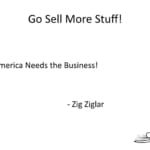






[…] and closing ten. This is why you’re the CFO right? 100 and closing ten. But it works with any marketing math you want to use here. We’ll use that math. Okay, Rocky your numbers are accepted and verified […]